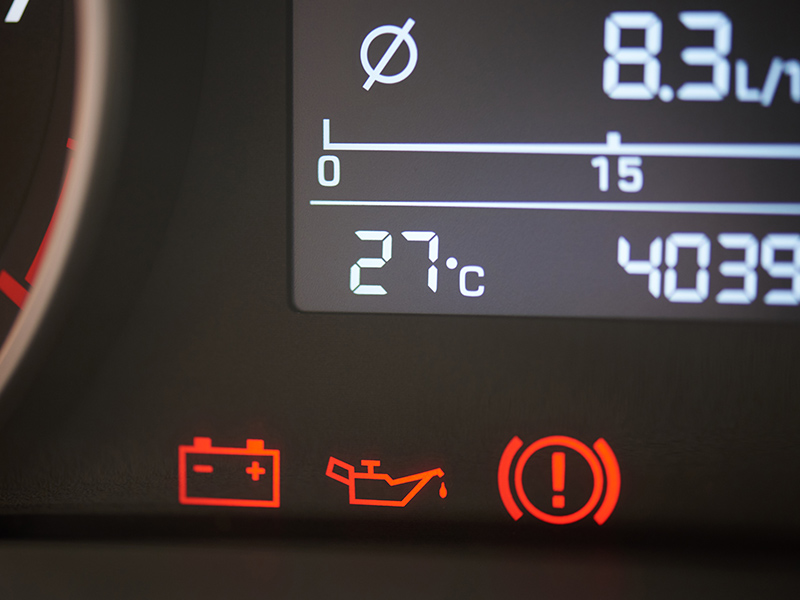Volvos are great vehicles. Reliable, safe, versatile, and well-loved the world over. Volvo owners love their cars, despite occasional issues. One such issue cropping up recently has been a problem with the “no oil pressure” warning light. This light can be concerning, as oil is an integral part of helping the engine function as it should. Because of that, we’re going to take a look at what might cause it to illuminate.
SYMPTOMS OF OIL PRESSURE PROBLEMS
A lot of questions come from owners who have purchased their older, higher mileage vehicle in the past 3-6 months. Most of them have been doing regular oil changes. As reported in the forums, drivers notice the no-oil-pressure warning signal illuminate. Sometimes the light stays on, but often it flashes off and on intermittently.
Many drivers indicate that the light tends to come on at lower RPMs than at higher. It can also go several days before recurring. Immediate checks of the engine oil dipstick often reveal a full complement of oil, usually clean, although some drivers may see that the oil looks a little dirty. With the obvious fix ruled out, we need to look a little deeper into the problem.
WHAT COULD BE SETTING THE SENSOR OFF?
The fact that most of these owners are at least the second owner of their Volvos and that they are all fairly high mileage vehicles can indicate a variety of possible culprits. Our first check would be for worn O-rings.
The O-ring, or gasket, is a seal connecting the oil pan with the engine block. Oil pan gaskets usually don’t fail, but, particularly in older vehicles with unknown previous owner history of oil changes, it’s not unheard of. How does the O-ring get damaged? The primary reason for O-ring or gasket damage in this location is sludge build up. A damaged oil pan gasket means that every time the pump cycles the oil through the engine, it’s pulling in air through the damaged gasket. Air cycling through the engine with the oil can cause the oil pressure to drop, particularly at lower RPMs.
SLUDGE: THE UGLY TRUTH
The oil you put into your vehicle changes over time due to constant exposure to high engine temperatures, moisture, and air. Old engine oil degrades into a thick, tar-like substance that no longer flows smoothly through the engine. Instead, gooey clumps of sludge deposit inside the engine, slowing and eventually blocking oil flow.
Without the consistent lubrication and engine-cooling functions provided by clean engine oil, your engine will eventually overheat and seize — the metal parts inside the engine get so hot they weld together and the engine becomes irreparably damaged.
PREVENTING SLUDGE
So, what can you do to protect your engine? First, follow manufacturer’s guidelines regarding regular maintenance for your Volvo, including regular oil and filter changes. Stop-and-go driving or short commutes put your Volvo at higher risk for sludge development. If this type of driving is part of your regular pattern, you may need to change oil more often. If you are the new owner of an older or higher mileage Volvo, your best plan is to have your system completely flushed and cleaned.
If your problem persists after a complete flush and clean and oil replacement, your technician can check for other triggers. We’ve also seen the no-oil-pressure alarm triggered by a bad or malfunctioning oil pressure sensor. Occasionally, the problem is caused by a broken PCV hose.
TRUST THE PROFESSIONALS
The potential for permanent damage to your engine means you need to get this checked out as soon as possible. You’ve put a lot of money and love into your Volvo. Act now to protect your investment by having your car thoroughly checked out by a licensed technician experienced in the intricacies of Volvo vehicles.
At Fast Lane European in San Jose, CA, we specialize in European imports. This means we have trained technicians standing by who know exactly how to handle your Volvo. Give us a call today and let us help you get that no oil pressure alarm issue tracked down and fixed, so you can be back out on the road in your Volvo — where you both belong!
 Mon – Fri: 8:30 AM – 5:30 PM
Mon – Fri: 8:30 AM – 5:30 PM 3585 Stevens Creek Blvd, San Jose, CA 95117
3585 Stevens Creek Blvd, San Jose, CA 95117 (408) 985-2000
(408) 985-2000 (408) 985-1000
(408) 985-1000





 Make An Appointment
Make An Appointment